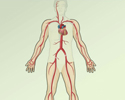Brain natriuretic peptide test
Brain natriuretic peptide (BNP) test is a blood test that measures levels of the protein BNP that is made by your heart and blood vessels. BNP levels are higher than normal when you have heart failure.
How the Test is Performed
A blood sample is needed. The blood is taken from a vein (venipuncture).
Venipuncture
Venipuncture is the collection of blood from a vein. It is most often done for laboratory testing.

This test is most often done in the emergency room or hospital. Results take up to 15 minutes. In some hospitals, a finger prick test with rapid results is available.
How the Test will Feel
When the needle is inserted to draw blood, you may feel a little pain. Most people feel only a prick or a stinging sensation. Afterward there may be some throbbing or bruising.
Why the Test is Performed
You may need this test if you have signs of heart failure. Symptoms include shortness of breath and swelling of your legs or abdomen. The test helps make sure your symptoms are due to your heart and not your lungs, kidneys, or liver.
It is unclear if repeated BNP tests are helpful in guiding treatment in those already diagnosed with heart failure.
Normal Results
In general, results of less than 100 picograms/milliliter (pg/mL) suggest a person does not have heart failure.
Normal value ranges may vary slightly among different laboratories. Some labs use different measurements or test different samples. Talk to your health care provider about the meaning of your specific test results.
What Abnormal Results Mean
BNP levels go up when the heart cannot pump the way it should.
A result greater than 100 pg/mL is abnormal. The higher the number, the more likely heart failure is present and the more severe it is.
Sometimes other conditions can cause high BNP levels. These include:
- Kidney failure
- Pulmonary embolism
- Pulmonary hypertension
- Severe infection (sepsis)
- Lung problems
Risks
Risks associated with having blood drawn are slight, but may include:
- Excessive bleeding
- Fainting or feeling lightheaded
- Hematoma (blood accumulating under the skin)
- Infection (a slight risk any time the skin is broken)
Considerations
A related test, called the N-terminal pro-BNP test, is done in the same way. It provides similar information, but the normal range is different.
References
Bock JL. Cardiac injury, atherosclerosis, and thrombotic disease. In: McPherson RA, Pincus MR, eds. Henry's Clinical Diagnosis and Management by Laboratory Methods. 24th ed. Philadelphia, PA: Elsevier; 2022:chap 19.
Felker GM, Teerlink JR. Diagnosis and management of acute heart failure. In: Libby P, Bonow RO, Mann DL, Tomaselli GF, Bhatt DL, Solomon SD, eds. Braunwald's Heart Disease: A Textbook of Cardiovascular Medicine. 12th ed. Philadelphia, PA: Elsevier; 2022:chap 49.
Heidenreich PA, Bozkurt B, Aguilar D, et al. 2022 AHA/ACC/HFSA Guideline for the Management of Heart Failure: A Report of the American College of Cardiology/American Heart Association Joint Committee on Clinical Practice Guidelines. Circulation. 2022;145(18):e895-e1032. PMID: 35363499 pubmed.ncbi.nlm.nih.gov/35363499/.
-
Heart failure
Animation
-
Congestive heart failure (CHF) overview
Animation
-
Blood test - illustration
Blood is drawn from a vein (venipuncture), usually from the inside of the elbow or the back of the hand. A needle is inserted into the vein, and the blood is collected in an air-tight vial or a syringe. Preparation may vary depending on the specific test.
Blood test
illustration
-
Heart - front view - illustration
The external structures of the heart include the ventricles, atria, arteries and veins. Arteries carry blood away from the heart while veins carry blood into the heart. The vessels colored blue indicate the transport of blood with relatively low content of oxygen and high content of carbon dioxide. The vessels colored red indicate the transport of blood with relatively high content of oxygen and low content of carbon dioxide.
Heart - front view
illustration
-
Blood test - illustration
Blood is drawn from a vein (venipuncture), usually from the inside of the elbow or the back of the hand. A needle is inserted into the vein, and the blood is collected in an air-tight vial or a syringe. Preparation may vary depending on the specific test.
Blood test
illustration
-
Heart - front view - illustration
The external structures of the heart include the ventricles, atria, arteries and veins. Arteries carry blood away from the heart while veins carry blood into the heart. The vessels colored blue indicate the transport of blood with relatively low content of oxygen and high content of carbon dioxide. The vessels colored red indicate the transport of blood with relatively high content of oxygen and low content of carbon dioxide.
Heart - front view
illustration
Review Date: 7/14/2024
Reviewed By: Michael A. Chen, MD, PhD, Associate Professor of Medicine, Division of Cardiology, Harborview Medical Center, University of Washington Medical School, Seattle, WA. Also reviewed by David C. Dugdale, MD, Medical Director, Brenda Conaway, Editorial Director, and the A.D.A.M. Editorial team.





